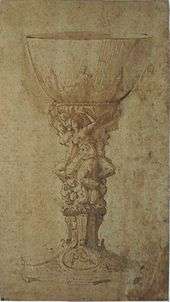Francesco de' Rossi

Francesco de' Rossi (1510–1563) was an Florentine Mannerist painter who lived and worked mainly in Florence, but also produced several works in Rome. He is known by many names, prominently the adopted name Francesco Salviati or as Il Salviati, but also Francesco Rossi and Cecchino del Salviati.
Biography
Salviati was born in Florence. He apprenticed under Giuliano Bugiardini, Baccio Bandinelli, Raffaele Brescianino, and finally Andrea del Sarto in 1529–30. In 1531 he traveled to Rome, where he met another Bandinelli pupil, Giorgio Vasari, and helped to complete the frescoes on the Life of John the Baptist in the Palazzo Salviati for the Cardinal Giovanni Salviati. It is from his attachment to this household that he took on the surname.
He frescoed an Annunciation in San Francesco a Ripa (1533–35). His mature style has mannerist contortions and crowded scenes similar to the output of Giulio Romano. In 1538 he joined Jacopino del Conte in completing a fresco of the Visitation[1] for the Oratory of San Giovanni Decollato, a Florentine fraternity ministering to persons who had been condemned to execution.
Salviati painted in Bologna in 1540 alongside Vasari, and stayed for a brief time in Venice, where he frescoed decorations for the Palazzo Grimani in antique style. During this period his style shows the influences of Parmigianino. His many portrait paintings can sometimes be confused for Bronzino.[2][3][4]

In 1543 Salviati returned to Florence. Working for Cosimo I de' Medici, Grand Duke of Tuscany, he completed a fresco decoration eulogizing the Medici family (Triumph of Camillus in the Sala dell'Udienza of the Palazzo Vecchio, 1543–45). He also designed tapestry cartoons for the recently established Arazzeria, including Ecce homo, Resurrection, and Joseph explains the Pharaoh's dreams. The latter commission was awarded after a competition, which pitted him against contemporary Florentine Mannerists, Bronzino and Pontormo. He painted a Deposition altarpiece for Santa Croce in 1547-48. This theme, one which became a master oeuvre topic for Late-Renaissance artists, is handled in a crowded complex fashion.
He often travelled to Rome between 1548 and 1563, to complete various fresco series, such as Wedding of Canae in the Oratory of the Piceni, a Birth of John the Baptist in the Oratory of San Giovanni Decollato, in the Palazzo della Cancelleria (Pallium Cappella), in the Palazzo Sacchetti (History of David[5]), and in Palazzo Farnese.
He died in Rome.
The Cleveland Museum of Art, the Courtauld Institute of Art (London), the Getty Museum, Harvard University Art Museums, the Hermitage Museum, the Honolulu Museum of Art, the Liechtenstein Museum (Vienna), the Louvre, the Metropolitan Museum of Art, Museo Poldi Pezzoli (Milan), Museum der bildenden Künste (Leipzig), the Museum of Fine Arts, Boston, the National Gallery of Art (Washington D.C.), Pinacoteca di Brera (Milan), Ringling Museum of Art (Florida), the Royal Museums of Fine Arts of Belgium, and the Saint Louis Art Museum are among the public collections holding paintings by Francesco de' Rossi.
Gallery
-

Portrait of a Young Man, oil on canvas painting by Francesco Salviati, c. 1550, Honolulu Museum of Art
-

Charity, 1554–58
-

Francesco de' Rossi's painting The Doubting of St. Thomas, 1543-1547.
-

Francesco de' Rossi's painting Portrait of a Man, 1540-1550
Footnotes
References
- Freedberg, Sydney J. (1993). Pelican History of Art, ed. Painting in Italy, 1500-1600. Penguin Books. pp. 437–442.
External links
| Wikimedia Commons has media related to Francesco Salviati. |
- Web Gallery of Art Biography of Salviati and images of works.
- The engravings of Giorgio Ghisi, a full text exhibition catalog from The Metropolitan Museum of Art, which contains material on Francesco de' Rossi (see index)
|